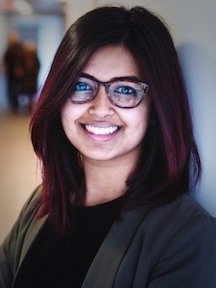By Ryan Maher
Nabiha Saklayen (ΦBK, Emory University), the CEO and co-founder of Cellino Biotech, is currently developing and marketing a novel gene editing procedure that stands to revolutionize work in cellular research and genetic therapy.
“Regenerative medicine may have captured our imagination, but very few therapies have yet to show clinical success,” Saklayen remarked at MIT Technology Review’s EmTech Conference in 2018. “In order to unlock the power of regenerative medicine, we must begin to engineer human cells with great precision.”
Biological scientists have sought this precise engineering for decades. Their efforts are substantially impeded by the cellular membrane, which hampers simple manipulation and prevents most foreign substances from entering a cell. Gold nanoparticles offer a promising avenue toward bypassing the membrane, but they are prone to chipping off into toxic subparticles that can damage cells. As a Ph.D. candidate in the Eric Mazur lab at Harvard, Saklayen helped to develop a platform consisting of gold microstructures, arranged in pyramids, that could channel energy more effectively and reliably.
In 2017, she and fellow Ph.D. candidate Marinna Madrid published their method of delivering material into a cell using the platform:
- A manufacturing technique called template stripping produces the array of gold, pyramid-shaped microstructures. These pyramids are bound to a flat surface, negating the dangers of free-floating particles in the targeted cells.
- The target (for example, a cluster of cancerous cells) is coated in a substance that contains the delivery materials (say, a certain protein) and placed on the array of pyramids.
- Laser pulses strike the array, which heat the tips of the pyramids to about 300 degrees Centigrade. The heated tips generate microscopic bubbles that push into the target without damaging its membrane.
- Through the holes in the target goes the delivery substance. The target’s membrane quickly closes, and the target remains unharmed and live.
The procedure is versatile, as the characteristics of the target (e.g. blood cells, T cells, cancerous cells) or the intended delivery (e.g. drugs and DNA) can vary widely. As a result, the innovation opens up many possibilities for therapies, cellular and genetic research, and treatments.
Enter Cellino Biotech, Saklayen and Madrid’s startup company to commercialize the innovation, dubbed “nanolace”. After winning the 2017 SPIE Startup Challenge, Cellino brought tech entrepreneur and engineer Matthias Wagner on board to ensure that the technology was marketable. Among them, they possess experience in fields as diverse as stem cell biology, nanofabrication, and tech entrepreneurship—skills necessary to develop, market, and usher in a potential revolution in cellular medicine.
Saklayen herself embraces the broad, multidisciplinary curiosity that The Phi Beta Kappa Society advocates. In her profile of Saklayen for MIT Technology Review’s “Innovators Under 35,” Katherine Bourzac writes, “Trained as a physicist, she is unusually comfortable with moving between scientific fields, including laser physics, nanomaterials, and synthetic biology. She credits her upbringing in Saudi Arabia, Bangladesh, Germany, and Sri Lanka with her adaptability. ‘I’m comfortable in new places, and at the interface of different fields,’ she says.”
An advocate for education, Saklayen also wants to expose a greater number of young students to these fields. She co-founded and co-directs the initiative I Am a Scientist, which issues classroom toolkits aimed at making students more aware of the diversity among American scientists and their backgrounds, experiences, and works. To Saklayen, a broader community of scientists and thinkers goes hand in hand with the sort of promising discoveries that she has uncovered. “If we choose to promote diversity in science,” she writes, “we open doors to major discoveries that could change how we make energy, travel in space, or cure cancer.”




